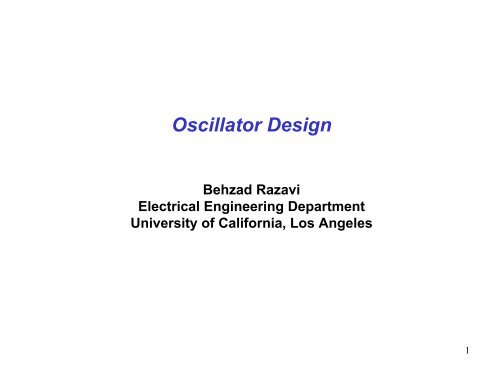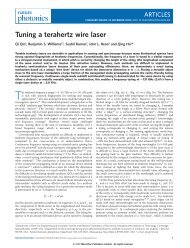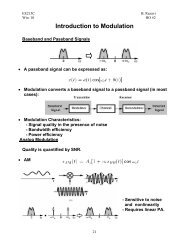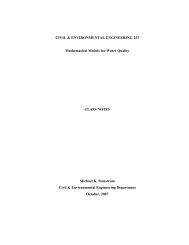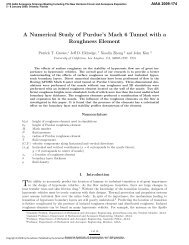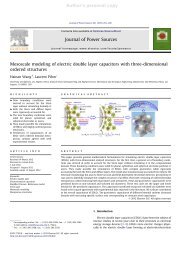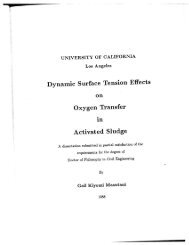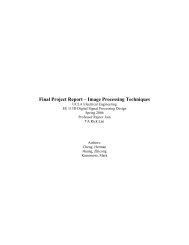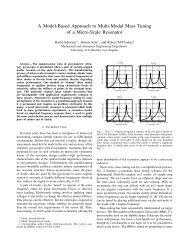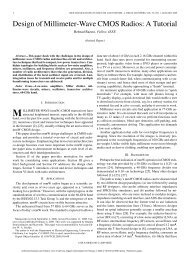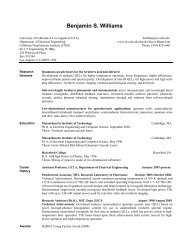Oscillator Design - UCLA Engineering
Oscillator Design - UCLA Engineering
Oscillator Design - UCLA Engineering
Create successful ePaper yourself
Turn your PDF publications into a flip-book with our unique Google optimized e-Paper software.
<strong>Oscillator</strong> <strong>Design</strong>Behzad RazaviElectrical <strong>Engineering</strong> DepartmentUniversity of California, Los Angeles1
Outline• Introduction• Basic Rings• Frequency Tuning• LC <strong>Oscillator</strong>s2
Small-Signal View3
Ring <strong>Oscillator</strong>s4
Linear Model5
Amplitude Limiting6
Basic Rings7
Other Rings8
Voltage-Controlled <strong>Oscillator</strong>s• Center Frequency• Tuning Range:- Band of Interest- PVT Variations• Gain (Sensitivity)• Supply Rejection• Tuning Linearity• Intrinsic Jitter• Output Amplitude9
Two Schools of Thought• Use differential rings lower supply sensitivityBut …• Use inverters with supply acting as control line. wider tuning rangeBut …10
Differential Ring VCOs (I)• But large swing variationacross tuning range• Ring with Replica Biasing[Young, JSSC, Nov. 92]11
Differential Ring VCOs (II)12
Tuning by Interpolation• Interpolation does not work well at low speeds.13
Example of Wide-Range Tuning[Maneatis, JSSC, Nov. 03]14
Single-Ended VCOs[van Kaenel, JSSC, Nov. 98][Mansuri, JSSC, Nov. 98]15
CCO with Regulation[Yan, ISSCC05]16
But how to generate complementary outputs?• Synchronize two rings:[Grozing, ESSCIRC 03]17
Other Examples[Searles, ISSCC07] (AMD)[Desai, ISSCC07] [Straayer, JSSC, April 09]18
18-GHz Ring in 65 nm[Gebara, ISSCC07]19
Measured Tuning Range[Gebara, ISSCC07]20
Another Example[Kossel, ISSCC05]21
Delay Stage[Kossel, ISSCC05]22
Simulated Behavior[Kossel, ISSCC05]23
LC <strong>Oscillator</strong>s• Much lower phase noise than rings(for a given power budget and frequency)• Much faster than rings• Much narrower tuning range• Main entry barrier: accurate inductor andvaractor models24
Basics25
MOS Varactors• Simpler to use than pn junctions.• C/V characteristic scales with technology.26
Q-Range Trade-Off27
Symmetric Inductors• Inductors driven differentially have a higher Q.28
Output Swing• Peak differential output voltage swing is givenby:29
3-Point <strong>Oscillator</strong>31
Oscillation Condition• Convert series resistance to parallel:32
Differential Topology• R1 appears in series with the parallel combination of L1and L2, lowering their Q and avoiding CM oscillation.33
Cross-Coupled <strong>Oscillator</strong>• Looks like a diff pair with positivefeedback.• Oscillation freq is given by:34
Problem of Swings• Peak Vds must not stress the transistors.35
Supply Sensitivity• Voltage-dependent Cdb results in a finite Kvcofrom Vdd to output frequency:36
One-Port View• Oscillation condition easier to meet than in 3-point topologies:37
Frequency Tuning (Type I)• To maximize tuning range, we wish to minimizeC1.• But C1 is given by:- Caps of M1 and M2 (including 4Cgd)-Cap of L1- Input cap of next stage38
Use of Symmetric Inductor• Requires accurate model of inductor. can’t begin design without a usefulinductor library.39
Tuning Range Limitations40
Effect of Varactor Q• Now include the varactor:41
VCO Type II• Select device dimension to set theoutput CM level to about Vdd/2.42
Varactor Modulation by I DD• Noise of current mirror becomes thedominant source.• Does this effect exist in Type I VCO?43
VCO Type III• Tuning range:• With 5% bottom-plate parasitic cap:44
VCO Type IV• Select device dimension to set theoutput CM level to about Vdd/2.• Output swing twice that of previoustopologies.• But tail noise modulates varactors.45
Oscillation Amplitude vs. Frequency• Suppose the tank inductor has onlya series resistance:• Oscillation amplitude falls as freq islowered.46
Discrete Tuning• But on-resistance of switches lowers tank Q:47
Use of “Floating” Switch48
LC VCO <strong>Design</strong> Procedure49
Application as Reference[McCorquodale, ISSCC08]50
Results[McCorquodale, ISSCC08]51
Mathematical Model of VCOs52


